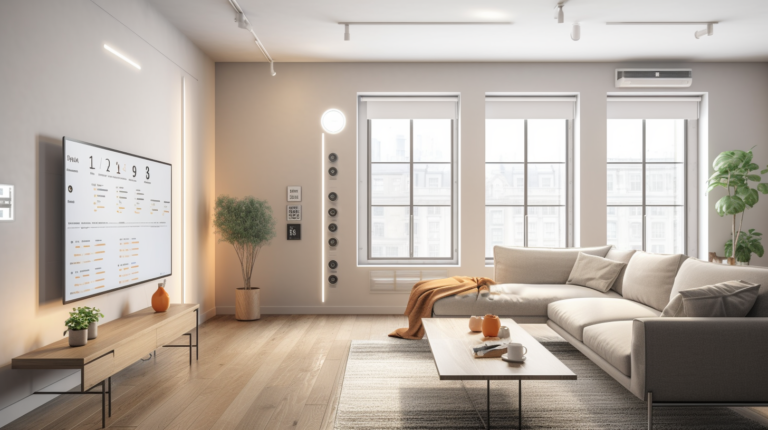Smart Power Strips: An Affordable Method of Cutting Phantom Energy
Did you realize that even when you turn off your electronics, they still need electricity? This “phantom energy” or “vampire power” is responsible for about 10% of the electricity used in US homes. Smart power strips are the perfect way to counteract this unseen energy drain for environmentally concerned renters who want to lessen their impact on the environment without making any long-term changes.
Comprehending Phantom Energy Waste
Phantom energy, often known as standby power, is the amount of electricity used by electronics that are plugged in but turned off. Typical offenders include:
- TVs, game consoles, and cable boxes are examples of entertainment systems.
- Kitchen appliances include toasters, microwaves, and coffee makers.
- Computers, printers, and monitors are examples of office equipment.
- Phone chargers and laptop adapters are examples of charging stations.
Small amounts of power are continuously consumed by these gadgets to preserve memory, react to remote commands, or just because of their poor design. Even if each gadget may only consume a tiny quantity of electricity, taken as a whole, they generate a substantial amount of waste.
The Operation of Smart Power Strips
Smart power strips actively control the flow of electricity, in contrast to conventional power strips, which only provide more outlets, based on:
- Usage patterns—scheduling
- Identifying when devices go into standby mode
- Remote controls – Enabling manual override via apps
- Current sensing – Identifying when a primary device shuts off
Because of these clever capabilities, smart power strips can automatically turn off gadgets that aren’t using electricity without you having to physically unplug anything.
Smart Power Strip Types for Various Rental Contexts
Strips with a Timer
Perfect for regular routines:
- Power shuts off automatically at predetermined periods
- Ideal for office settings or entertainment systems that are only utilized during specific hours
- Easy to program
- Independent of Wi-Fi
Strips for Current Sensing
Excellent for entertainment venues:
- Recognize when a main device, such as your TV, shuts off
- Automatically switch off peripheral devices, such as speakers and game consoles
- No scheduling or programming is necessary
The Kasa Smart Plug Power Strip HS300 features three USB ports, six independently programmable outlets, and energy monitoring features that elevate energy management to a new level. Set schedules, monitor the energy use of linked devices, and control each outlet independently via the app.
Strips with Wi-Fi Connectivity
Ideal for renters that are tech-savvy:
- Use smartphone apps to remotely control outlets and create complex schedules for various gadgets
- Energy usage monitoring is frequently included
- Voice assistants like Google Home and Alexa are integrated
Separate Smart Plugs
For dispersed problematic devices:
- Best to deploy only where necessary rather than changing complete systems
- Easy to move between rooms or between rentals
- Frequently less expensive when focusing on a small number of phantom energy sources
Placement in Rental Spaces Strategically
Give priority to these places for the greatest impact:
Zones for Home Entertainment
- Put strips behind TV consoles so you may control several devices at once
- Set up to identify the TV as the control device
- Add speakers, game consoles, and streaming devices
Areas for Home Offices
- After work hours, turn off devices using timer-based strips
- Make sure to turn off printers, desk lighting, and computer peripherals
- Establish weekend schedules that differ from daily ones
Command Centers for Kitchens
- Target tiny appliances that are always plugged in but little used, such as toasters, coffee machines, and charging stations
- For large adapters, think about using strips with outlets placed farther apart
Implementation Friendly to Roommates
In communal living areas:
- Indicate clearly which gadgets belong in which outlets
- Talk about scheduling to take into account various routines
- Think about using distinct colors for different users or zones
- Make basic guidelines for short-term visitors
Analysis of Cost and Benefit
Despite the initial cost, smart power strips usually pay for themselves through energy savings.
- The average apartment’s phantom energy costs range from $100 to $200 per year, while entry-level smart strips start at about $20
- Using smart strips strategically could result in 50–80% savings
- An extra advantage is that electronics last longer when the power is entirely cut off
The Benefit of Moving Day
In contrast to long-term energy-saving changes, smart power strips are portable:
- There’s no need to return anything to “original condition”
- You can unplug and pack it like any other electrical device
- Adjust it to the architecture of your new room
- Progressively add to your collection with each new rental
Smart power strips are among the most practical, reasonably priced, and portable options available for renters who care about the environment and want to make a significant difference in lowering their carbon footprint without having to deal with their landlord. Regardless of your renting arrangement, you can reduce wasteful electricity consumption and save money by focusing on the invisible drain of phantom energy.





